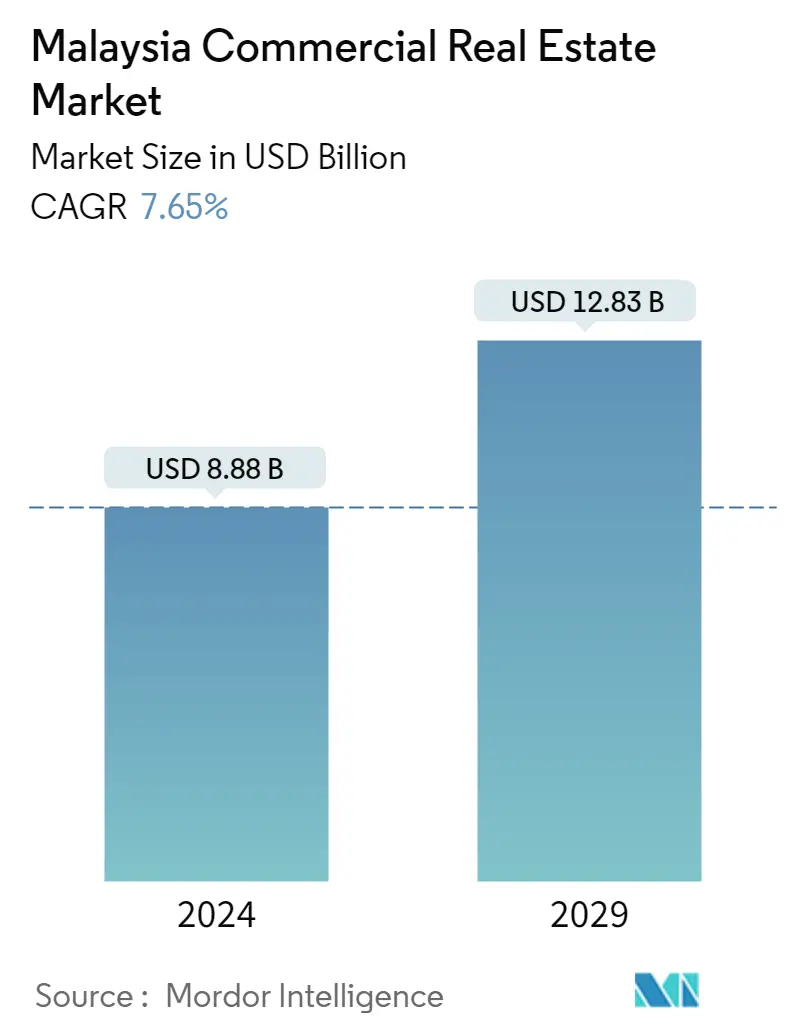Market Size of Malaysia Commercial Real Estate Industry

| Study Period | 2020 - 2029 |
| Base Year For Estimation | 2023 |
| Market Size (2024) | USD 8.88 Billion |
| Market Size (2029) | USD 12.83 Billion |
| CAGR (2024 - 2029) | 7.65 % |
| Market Concentration | Low |
Major Players
*Disclaimer: Major Players sorted in no particular order |
Malaysia Commercial Real Estate Market Analysis
The Malaysia Commercial Real Estate Market size is estimated at USD 8.88 billion in 2024, and is expected to reach USD 12.83 billion by 2029, growing at a CAGR of 7.65% during the forecast period (2024-2029).
- As per industry experts, in the first half of 2022 (H1 22), across property market performance in the Klang Valley, Penang, Johor Baru, Johor, and Kota Kinabalu in Sabah, the industrial real estate sector continued to grow in comparison to the retail industry. The industrial sector has consistently grown over the past few years due to rising e-commerce penetration rates. The rise in long-distance shipping increased the need for warehouse space and a structural change toward omnichannel retailing. There is strong interest in selling or buying existing commercial assets (land or buildings) in Sabah, Johor, and Klang Valley, whether taking advantage of bargains for high-quality assets or implementing a portfolio rationalization exercise. The Logistics and Industrial sub-sectors remain the real estate industry's new darlings. As people exit pandemic management after two years, there is a clear interest in the Healthcare sub-sector becoming an alternative investment to watch.
- According to Industry experts, the real estate market in Malaysia is slowly improving as buyers are still dealing with the repercussions of COVID-19. According to the company's most recent research on the Malaysian real estate market, the Landed Property Sale Price Index increased by 1.1% quarter over quarter and 3.64% year over year in the second quarter (Q2) of 2022. It is accompanied by a 5.21% increase but a QoQ decline of 1.96% in the Landed Property Sale Demand Index. Even though potential purchasers are discouraged by affordability and financial instability challenges, the group claimed that the pattern showed that landed properties are still the preferred purchasing option. It led to slower demand for homes.
- Year-on-year (y-o-y), Malaysia's volume of property transactions registered a 1.78% marginal drop in the first nine months of 2021 to clock in at 201,068 transactions. However, the transaction value rebounded nearly 14% to almost MYR 98 billion (USD 22.10 billion) or up to about MYR 11.2 billion (USD 2.53 billion) in 2020. Investments into the Office, Retail, Hotel / Leisure, Industrial, and Logistics sub-sectors will increase in 2022-23. Developers have increased their investment across the board in all sub-sectors, indicating increased activity in 2022-23 over the previous two years. Managers of mutual funds and real estate investment trusts have increased their exposure to industrial and hospitality assets, with a roughly equal distribution in the other sub-sectors. Lenders have reduced their exposure in almost all sub-sectors except the Office sub-sector.
Malaysia Commercial Real Estate Industry Segmentation
Commercial real estate (CRE) is the land only used for business-related activities or to offer a workspace instead of being utilized as a residence, which would fall under the residential real estate category. Most frequently, renters lease commercial real estate to conduct businesses that generate cash. The report also covers the impact of COVID-19 on the market.
The Malaysia Commercial Real Estate Market is segmented by type (offices, retail, industrial, logistics, multi-family, and hospitality) and key cities (Kuala Lumpur, Seberang Perai, Kajang, Klang, and the rest of Malaysia). The report offers market size and forecasts for the Malaysia Commercial Real Estate market in value (USD) for all the above segments.
| By Type | |
| Offices | |
| Retail | |
| Industrial | |
| Logistics | |
| Multi-family | |
| Hospitality |
| By Key Cities | |
| Kuala Lumpur | |
| Seberang Perai | |
| Kajang | |
| Klang | |
| Rest of Malaysia |
Malaysia Commercial Real Estate Market Size Summary
The Malaysia Commercial Real Estate Market is poised for significant growth, driven by evolving industry dynamics and increasing demand across various sectors. The industrial real estate sector has shown resilience and expansion, largely due to the surge in e-commerce and the need for enhanced logistics and warehouse spaces. This trend is supported by a structural shift towards omnichannel retailing, which has spurred interest in commercial assets in regions like Sabah, Johor, and Klang Valley. Despite the challenges posed by the pandemic, the market is witnessing a gradual recovery, with the healthcare sub-sector emerging as a promising alternative investment. The market's fragmentation presents opportunities for growth, with key players such as Conlay Construction, YTL Corporation, and IJM Corporation actively participating in the development of new, cost-effective real estate solutions.
The market's trajectory is further influenced by government initiatives and private sector investments, which have been pivotal in sustaining construction activities. The government's financial support through schemes like the Guaranteed Credit Housing Scheme and the PEMULIH aid package has been instrumental in bolstering the construction sector, particularly in addressing the rising costs of building materials. The private sector continues to dominate the construction landscape, with significant contributions from residential and non-residential projects. Technological advancements, particularly in proptech, are enhancing transaction volumes and asset management, driving the market forward. Notable developments, such as Skyworld Development's new projects in Kuala Lumpur and Gamuda Bhd's acquisition of land for mixed development, underscore the market's potential and the strategic focus on high-value opportunities both domestically and internationally.
Malaysia Commercial Real Estate Market Size - Table of Contents
-
1. MARKET INSIGHTS AND DYNAMICS
-
1.1 Market Overview
-
1.2 Market Drivers
-
1.2.1 Growth trajectory with a steady pipeline of distribution and warehouse projects
-
1.2.2 Increasing investment in Greater Kuala Lumpur for Office Space
-
-
1.3 Market Restraints
-
1.3.1 Rising commodity prices
-
-
1.4 Market Oppurtunities
-
1.4.1 The ongoing mega projects will have a positive multiplier effect for the commercial property market
-
-
1.5 Insights into Supply Chain/Value Chain Analysis
-
1.6 Industry Attractiveness - Porter's Five Forces Analysis
-
1.6.1 Bargaining Power of Suppliers
-
1.6.2 Bargaining Power of Buyers/Consumers
-
1.6.3 Threat of New Entrants
-
1.6.4 Threat of Substitute Products
-
1.6.5 Intensity of Competitive Rivalry
-
-
1.7 Government Regulations and Initiatives
-
1.8 Technological Trends
-
1.9 Insights into Existing and Upcoming Projects
-
1.10 Insights into Interest Rate Regime for General Economy and Real Estate Lending
-
1.11 Insights into Rental Yields in the Commercial Real Estate Segment
-
1.12 Insights into Real Estate Tech and Startups Active in the Real Estate Segment (Broking, Social Media, Facility Management, and Property Management)
-
1.13 Impact of COVID-19 on the Market
-
-
2. MARKET SEGMENTATION
-
2.1 By Type
-
2.1.1 Offices
-
2.1.2 Retail
-
2.1.3 Industrial
-
2.1.4 Logistics
-
2.1.5 Multi-family
-
2.1.6 Hospitality
-
-
2.2 By Key Cities
-
2.2.1 Kuala Lumpur
-
2.2.2 Seberang Perai
-
2.2.3 Kajang
-
2.2.4 Klang
-
2.2.5 Rest of Malaysia
-
-
Malaysia Commercial Real Estate Market Size FAQs
How big is the Malaysia Commercial Real Estate Market?
The Malaysia Commercial Real Estate Market size is expected to reach USD 8.88 billion in 2024 and grow at a CAGR of 7.65% to reach USD 12.83 billion by 2029.
What is the current Malaysia Commercial Real Estate Market size?
In 2024, the Malaysia Commercial Real Estate Market size is expected to reach USD 8.88 billion.

